2018 MERCEDES-BENZ GLS mirror
[x] Cancel search: mirrorPage 25 of 398
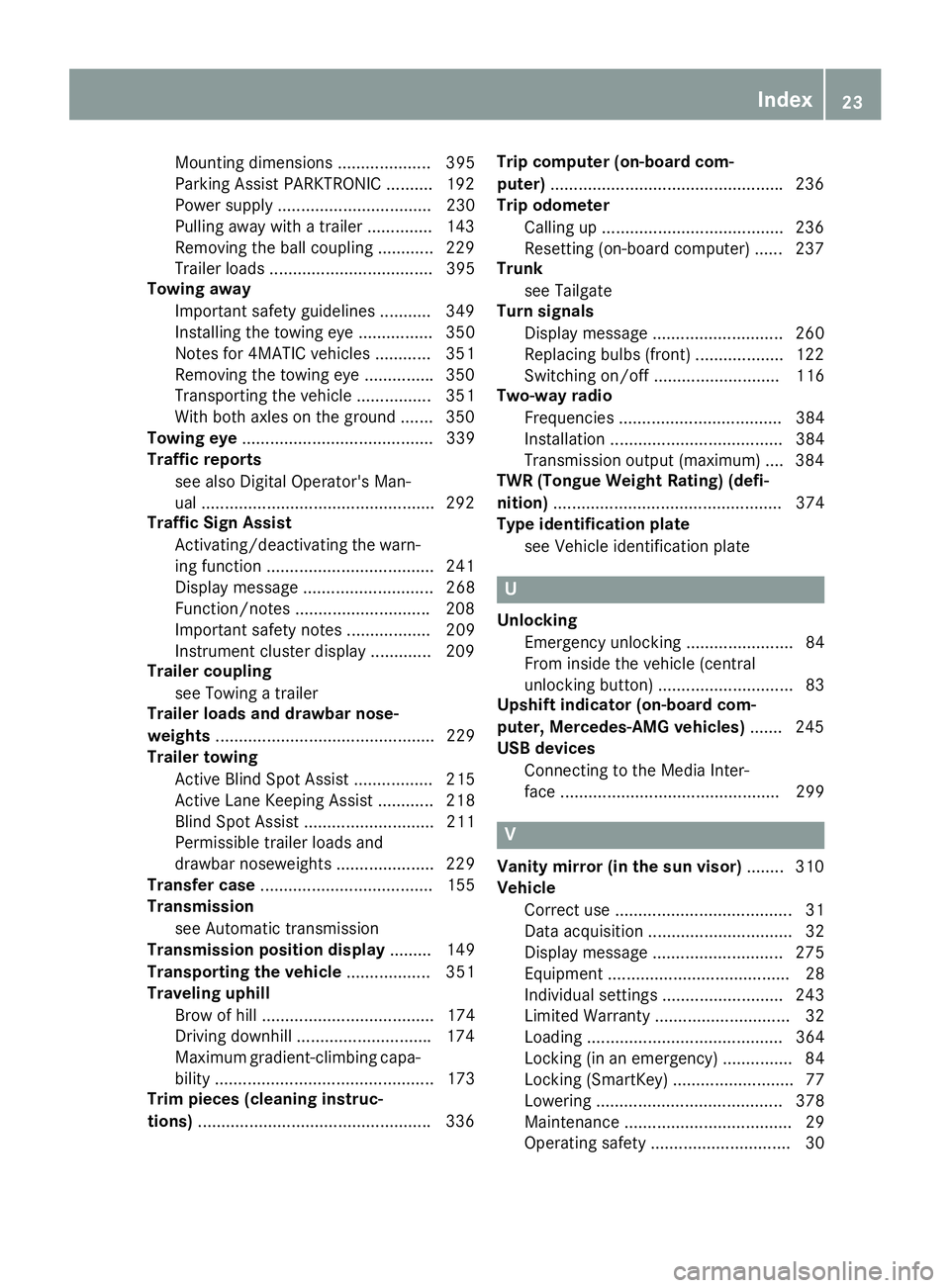
Mounting dimensions .................... 395
Parking Assist PARKTRONIC ......... .1 92
Power supply ................................. 230
Pulling away with a trailer .............. 143
Removing the ball coupling ............ 229
Trailer loads ................................... 395
Towing away
Important safety guidelines ........... 349
Installing the towing eye ................ 350
Notes for 4MATIC vehicles ............ 351
Removing the towing eye .............. .3 50
Transporting the vehicle ................ 351
With both axles on the ground ....... 350
Towing eye ......................................... 339
Traffic reports
see also Digital Operator's Man-
ual ................................................. .2 92
Traffic Sign Assist
Activating/deactivating the warn-
ing function ................................... .2 41
Display message ............................ 268
Function/notes ............................ .2 08
Important safety notes .................. 209
Instrument cluster display ............. 209
Trailer coupling
see Towing a trailer
Trailer loads and drawbar nose-
weights ............................................... 229
Trailer towing
Active Blind Spot Assist ................. 215
Active Lane Keeping Assist ............ 218
Blind Spot Assist ............................ 211
Permissible trailer loads and
drawbar noseweights ..................... 229
Transfer case ..................................... 155
Transmission
see Automatic transmission
Transmission position display ......... 149
Transporting the vehicle .................. 351
Traveling uphill
Brow of hill ..................................... 174
Driving downhill ............................ .1 74
Maximum gradient-climbing capa-
bility ............................................... 173
Trim pieces (cleaning instruc-
tions) ................................................. .3 36 Trip computer (on-board com-
puter) ................................................. .2 36
Trip odometer
Calling up ................................... .... 236
R es
etting (on-board computer) ...... 237
Trunk
see Tailgate
Turn signals
Display message ............................ 260
Replacing bulbs (front) ................... 122
Switching on/off ........................... 116
Two-way radio
Frequencies ................................... 384
Installation ..................................... 384
Transmission output (maximum) .... 384
TWR (Tongue Weight Rating) (defi-
nition) ................................................. 374
Type identification plate
see Vehicle identification plate
U Unlocking
Emergency unlocking ....................... 84
From inside the vehicle (central
unlocking button) ............................. 83
Upshift indicator (on-board com-
puter, Mercedes-AMG vehicles) ....... 245
USB devices
Connecting to the Media Inter-
face ............................................... 299
V
Vanity mirror (in the sun visor) ........ 310
Vehicle
Correct use ...................................... 31
Data acquisition ............................... 32
Display message ............................ 275
Equipment ....................................... 28
Individual settings .......................... 243
Limited Warranty ............................. 32
Loading .......................................... 364
Locking (in an emergency) ............... 84
Locking (SmartKey) .......................... 77
Lowering ........................................ 378
Maintenance .................................... 29
Operating safety .............................. 30 Index 23
Page 99 of 398
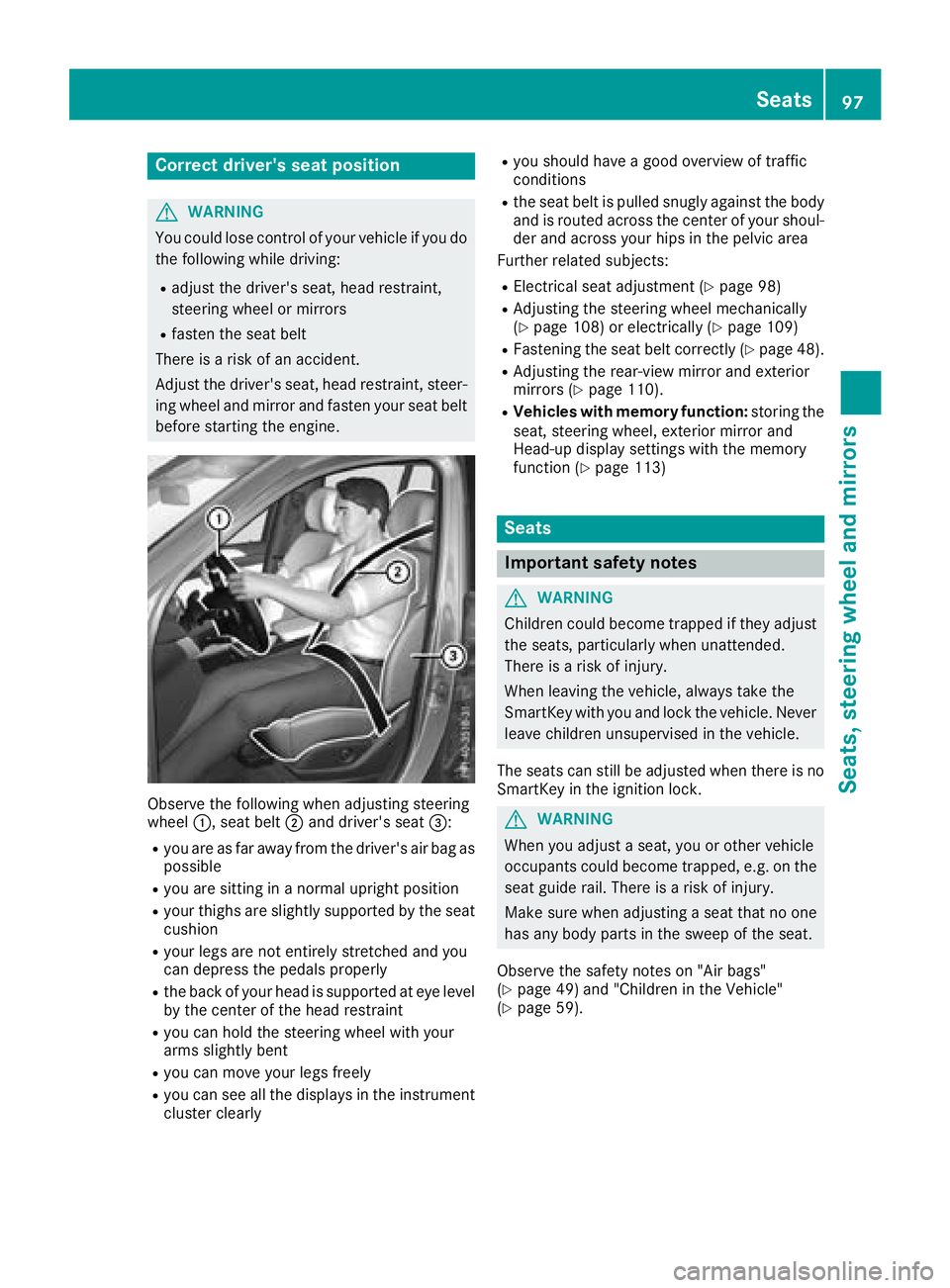
Correct driver's seat position
G WARNING
You could lose control of your vehicle if you do
the following while driving: R
adjust the driver's seat, head restraint,
steering wheel or mirrors R
fasten the seat belt
There is a risk of an accident.
Adjust the driver's seat, head restraint, steer-
ing wheel and mirror and fasten your seat belt
before starting the engine.
Observe the following when adjusting steering
wheel �C , seat belt �D and driver's seat �
Page 100 of 398
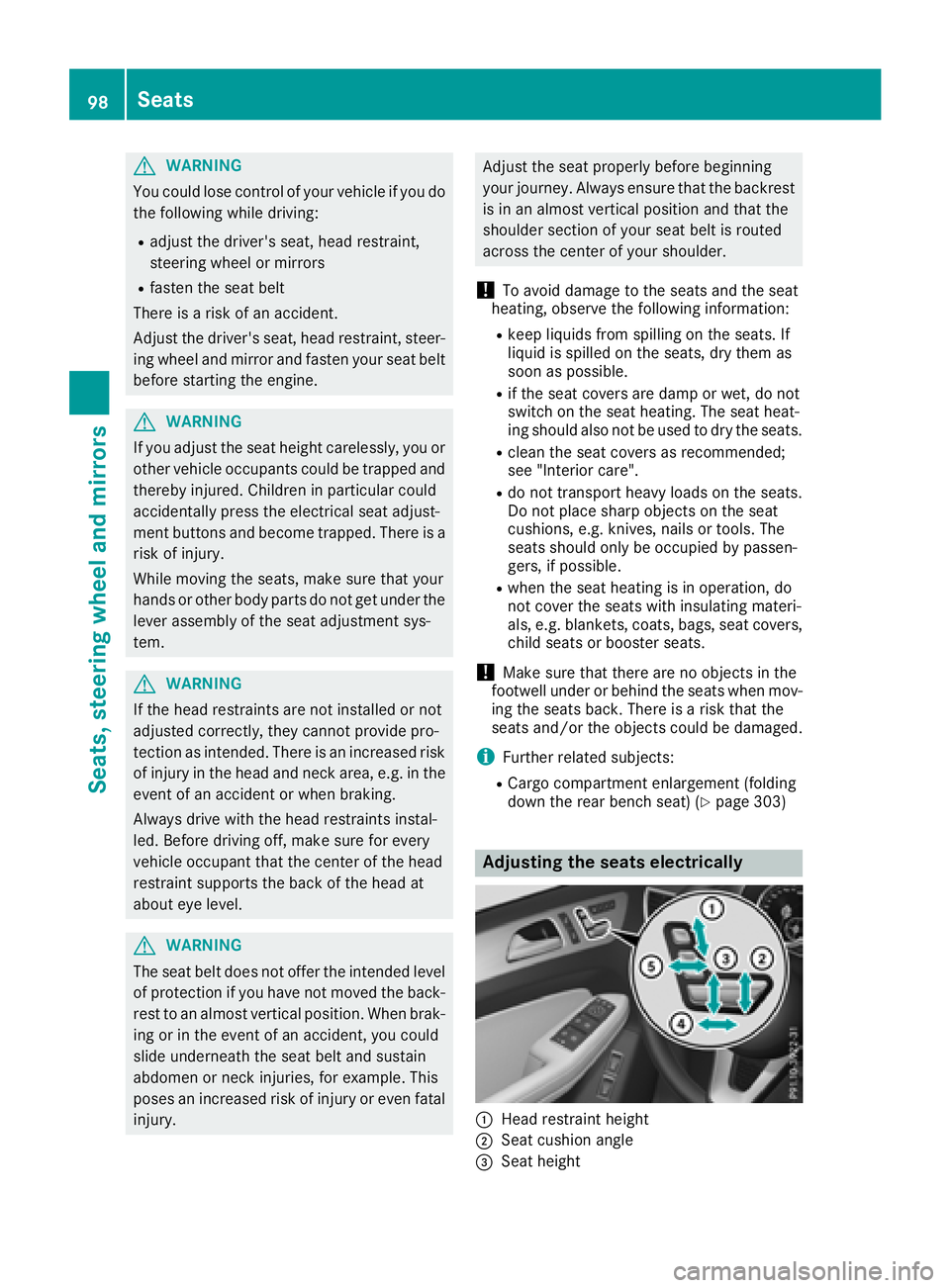
G WARNING
You could lose control of your vehicle if you do
the following while driving: R
adjust the driver's seat, head restraint,
steering wheel or mirrors R
fasten the seat belt
There is a risk of an accident.
Adjust the driver's seat, head restraint, steer-
ing wheel and mirror and fasten your seat belt
before starting the engine.
G WARNING
If you adjust the seat height carelessly, you or
other vehicle occupants could be trapped and
thereby injured. Children in particular could
accidentally press the electrical seat adjust-
ment buttons and become trapped. There is a
risk of injury.
While moving the seats, make sure that your
hands or other body parts do not get under the
lever assembly of the seat adjustment sys-
tem.
G WARNING
If the head restraints are not installed or not
adjusted correctly, they cannot provide pro-
tection as intended. There is an increased risk
of injury in the head and neck area, e.g. in the
event of an accident or when braking.
Always drive with the head restraints instal-
led. Before driving off, make sure for every
vehicle occupant that the center of the head
restraint supports the back of the head at
about eye level.
G WARNING
The seat belt does not offer the intended level
of protection if you have not moved the back-
rest to an almost vertical position. When brak-
ing or in the event of an accident, you could
slide underneath the seat belt and sustain
abdomen or neck injuries, for example. This
poses an increased risk of injury or even fatal
injury. Adjust the seat properly before beginning
your journey. Always ensure that the backrest
is in an almost vertical position and that the
shoulder section of your seat belt is routed
across the center of your shoulder.
! To avoid damage to the seats and the seat
heating, observe the following information: R
keep liquids from spilling on the seats. If
liquid is spilled on the seats, dry them as
soon as possible. R
if the seat covers are damp or wet, do not
switch on the seat heating. The seat heat-
ing should also not be used to dry the seats. R
clean the seat covers as recommended;
see "Interior care". R
do not transport heavy loads on the seats.
Do not place sharp objects on the seat
cushions, e.g. knives, nails or tools. The
seats should only be occupied by passen-
gers, if possible. R
when the seat heating is in operation, do
not cover the seats with insulating materi-
als, e.g. blankets, coats, bags, seat covers,
child seats or booster seats.
! Make sure that there are no objects in the
footwell under or behind the seats when mov-
ing the seats back. There is a risk that the
seats and/or the objects could be damaged.
i Further related subjects: R
Cargo compartment enlargement (folding
down the rear bench seat) ( Y
page 303)
Adjusting the seats electrically
�C
Head restraint height
�D
Seat cushion angle
�
Page 102 of 398
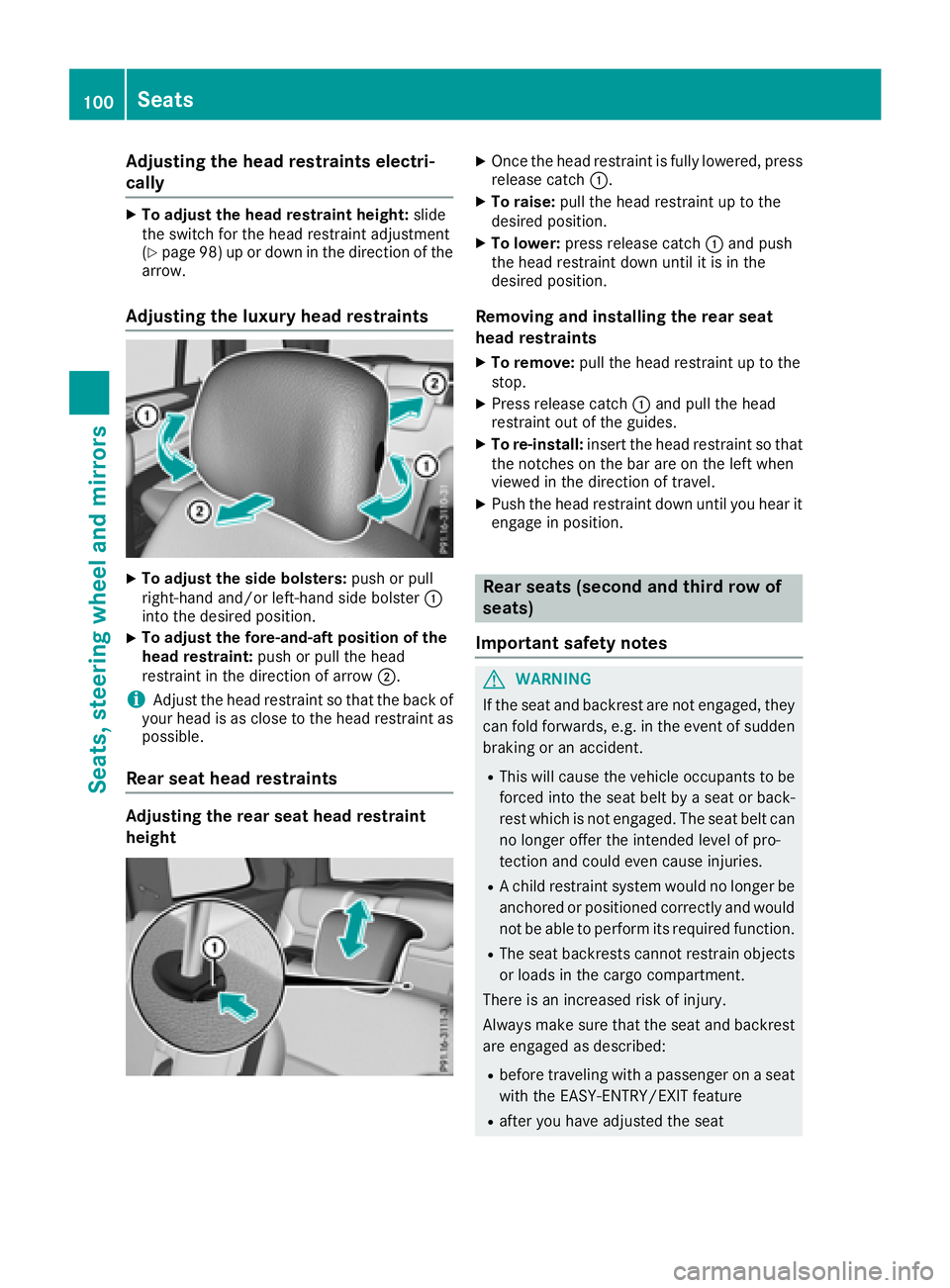
Adjusting the head restraints elect ri -
cally X
To adjust th e hea d restrain t height : slid e
th e switch for th e head restrain t adjustmen t
( Y
page 98) up or down in th e direction of th e
arrow.
Adjusting the luxury head restraints X
To adjust th e sid e bolsters : push or pull
right-hand and/o r left-han d side bolste r �C
int o th e desired position .X
To adjust th e fore-and-aft position of th e
hea d restraint: push or pull th e head
restrain t in th e direction of arrow �D .
i Adjus t th e head restrain t so that th e bac k of
your head is as close to th e head restrain t as
possible.
Rear seat head restraints
Adjusting th e rea r sea t hea d restrain t
height X
Once th e head restrain t is fully lowered, press
release catch �C . X
To raise: pull th e head restrain t up to th e
desired position . X
To lower : press release catch �C and push
th e head restrain t down until it is in th e
desired position .
Removin g and installing th e rea r sea t
hea d restraints X
To remove: pull th e head restrain t up to th e
stop. X
Press release catch �C and pull th e head
restrain t out of th e guides.X
To re-install : insert th e head restrain t so that
th e notches on th e bar are on th e lef t when
viewed in th e direction of travel .X
Push th e head restrain t down until you hear it
engage in position .
Rear seats (second and third row of
seats)
Import ant safety notes
G WARNIN G
If th e seat and backrest are no t engaged, they
can fol d forwards, e.g. in th e event of sudde n
braking or an accident. R
This will caus e th e vehicl e occupant s to be
force d int o th e seat belt by a seat or back-
res t whic h is no t engaged. The seat belt can
no longer offer th e intended level of pro -
tection and could eve n caus e injuries.R
A child restrain t system would no longer be
anchored or positioned correctl y and would
no t be able to perfor m it s require d function .R
The seat backrest s canno t restrain objects
or loads in th e cargo compartment.
There is an increased ris k of injury.
Always mak e sur e that th e seat and backrest
are engage d as described: R
before traveling wit h a passenger on a seat
wit h th e EASY-ENTRY/EXIT feature R
after you hav e adjusted th e seat100
Seats
Seats, steering wheel and mirrors
Page 103 of 398
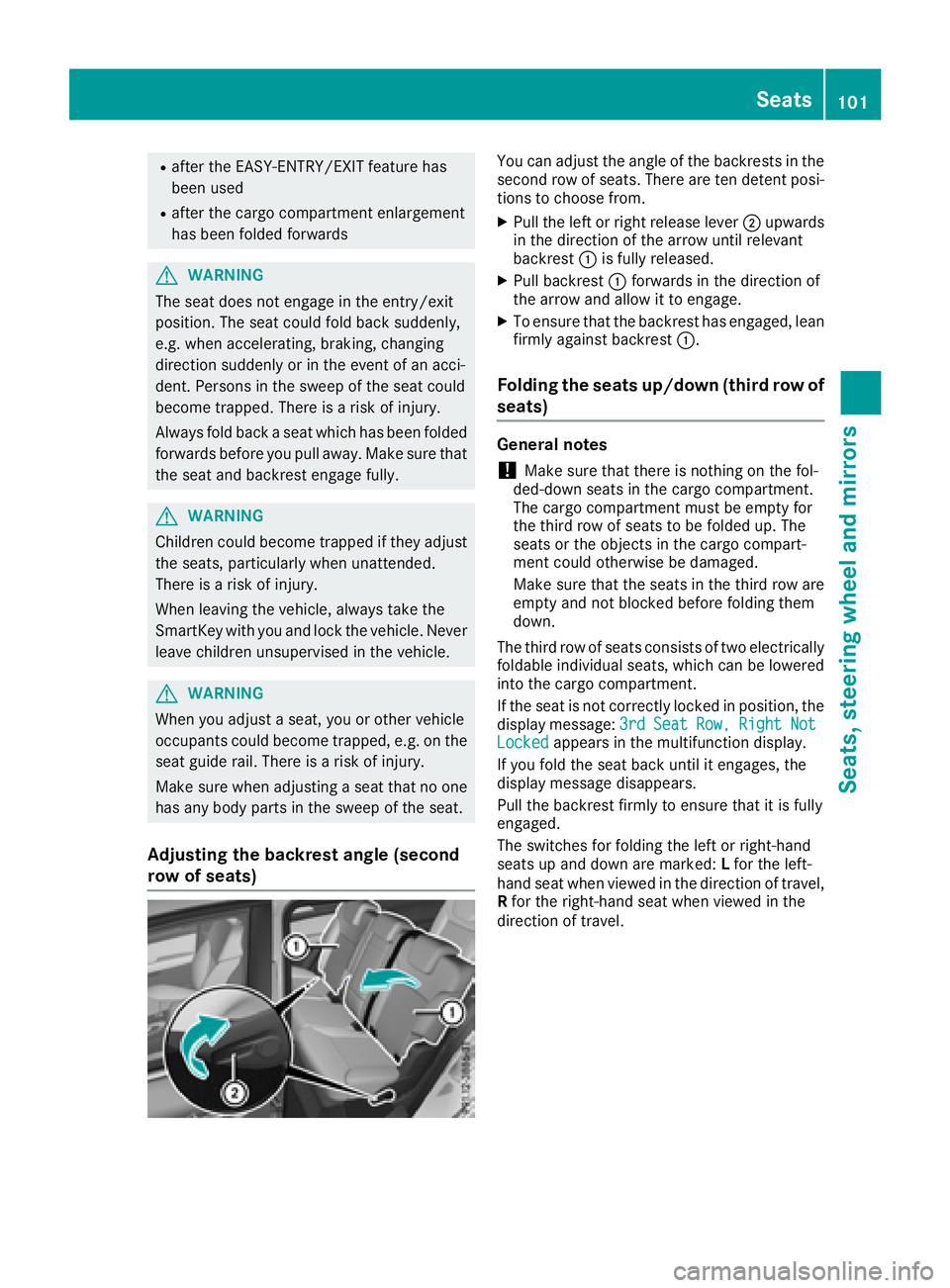
R
after the EASY-ENTRY/EXIT feature has
been used R
after the cargo compartment enlargement
has been folded forwards
G WARNING
The seat does not engage in the entry/exit
position. The seat could fold back suddenly,
e.g. when accelerating, braking, changing
direction suddenly or in the event of an acci-
dent. Persons in the sweep of the seat could
become trapped. There is a risk of injury.
Always fold back a seat which has been folded
forwards before you pull away. Make sure that
the seat and backrest engage fully.
G WARNING
Children could become trapped if they adjust
the seats, particularly when unattended.
There is a risk of injury.
When leaving the vehicle, always take the
SmartKey with you and lock the vehicle. Never
leave children unsupervised in the vehicle.
G WARNING
When you adjust a seat, you or other vehicle
occupants could become trapped, e.g. on the
seat guide rail. There is a risk of injury.
Make sure when adjusting a seat that no one
has any body parts in the sweep of the seat.
Adjusting the backrest angle (second
row of seats) You can adjust the angle of the backrests in the
second row of seats. There are ten detent posi-
tions to choose from. X
Pull the left or right release lever �D upwards
in the direction of the arrow until relevant
backrest �C is fully released. X
Pull backrest �C forwards in the direction of
the arrow and allow it to engage. X
To ensure that the backrest has engaged, lean
firmly against backrest �C .
Folding the seats up/down (third row of
seats) General notes
! Make sure that there is nothing on the fol-
ded-down seats in the cargo compartment.
The cargo compartment must be empty for
the third row of seats to be folded up. The
seats or the objects in the cargo compart-
ment could otherwise be damaged.
Make sure that the seats in the third row are
empty and not blocked before folding them
down.
The third row of seats consists of two electrically
foldable individual seats, which can be lowered
into the cargo compartment.
If the seat is not correctly locked in position, the
display message: 3rd Seat Row, Right Not
Locked appears in the multifunction display.
If you fold the seat back until it engages, the
display message disappears.
Pull the backrest firmly to ensure that it is fully
engaged.
The switches for folding the left or right-hand
seats up and down are marked: L for the left-
hand seat when viewed in the direction of travel,
R for the right-hand seat when viewed in the
direction of travel. Seats 101
Seats, steering wheel and mirrors Z
Page 104 of 398
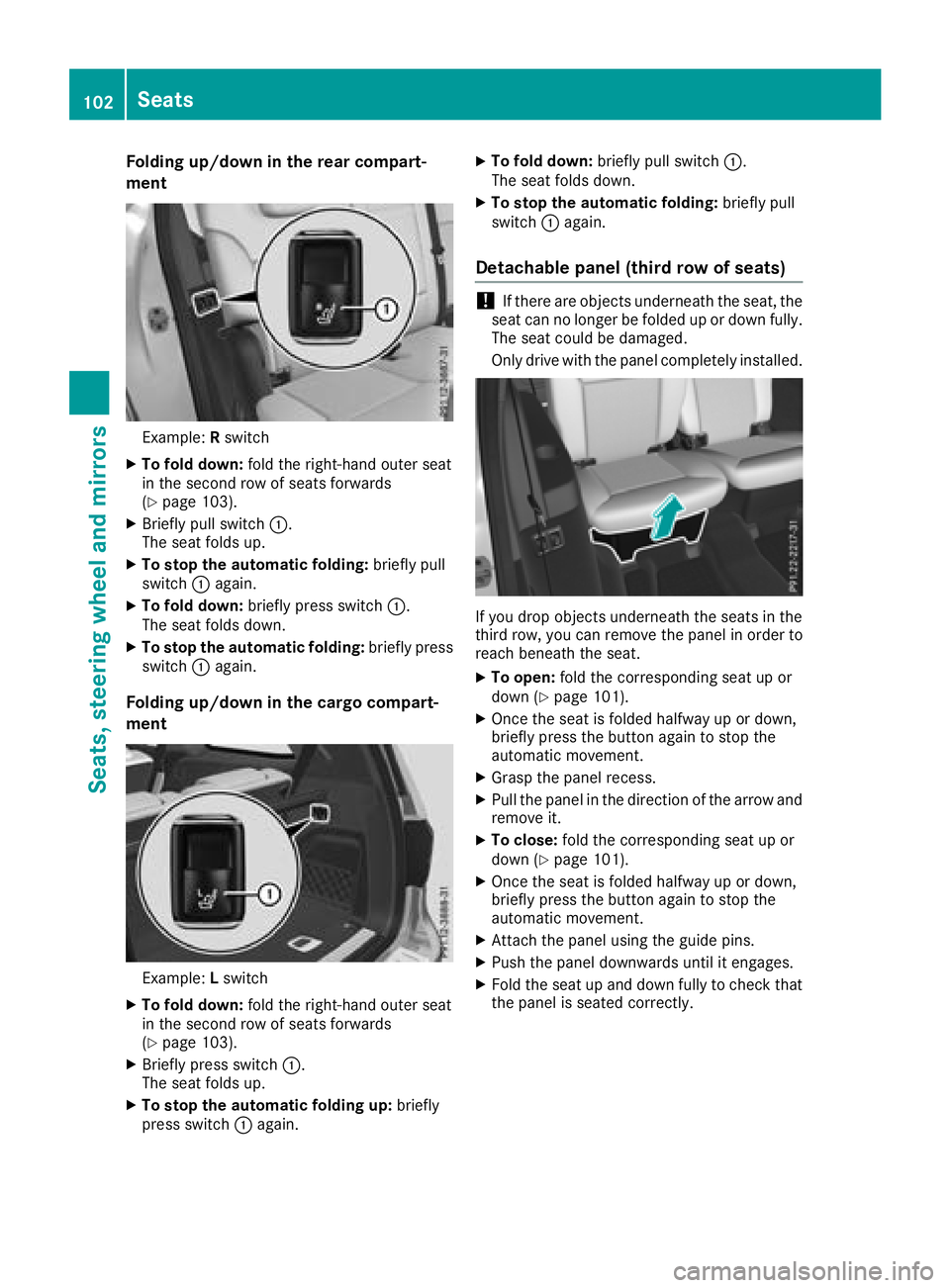
Folding up/down in the rear compart-
ment
Example: R swit chX
To fold down: fold the right-hand outer seat
in the second row of seats forwards
( Y
page 103).X
Briefly pull swit ch �C .
The seat fol ds up.X
To st op the automatic folding: brie fly pull
swit ch �C again.X
To fold down: brie fly press swit ch �C .
The seat fol ds down .X
To st op the automatic folding: brie fly press
swit ch �C again.
Folding up/down in the cargo compart-
ment
Example: L swit chX
To fold down: fold the right-hand outer seat
in the second row of seats forwards
( Y
page 103).X
Briefly press swit ch �C .
The seat fol ds up.X
To st op the automatic folding up: brie fly
press swit ch �C again. X
To fold down: briefly pull swit ch �C .
The seat folds down. X
To st op the au tom atic folding: briefly pull
swit ch �C again.
Detachable panel (third row of seats)
! If there are objects underneath the seat, the
seat can no longer be folded up or down fully.
The seat could be damaged.
Only drive with the panel co mple te ly installed.
If you drop objects underneath the seats in the
third row, you can remove the panel in order to
reach beneath the seat. X
To open: fold the corresponding seat up or
down ( Y
page 101). X
Once the seat is folded halfway up or down,
briefly press the button again to stop the
automat ic movement. X
Grasp the panel recess. X
Pull the panel in the direction of the arrow and
remove it. X
To close: fold the corresponding seat up or
down ( Y
page 101). X
Once the seat is folded halfway up or down,
briefly press the button again to stop the
automatic movement. X
Attach the panel using the guide pins. X
Push the panel downwards until it engages. X
Fold the seat up and down fully to check that
the panel is seated correctly.102
Seats
Seats, steering wheel and mirrors
Page 105 of 398
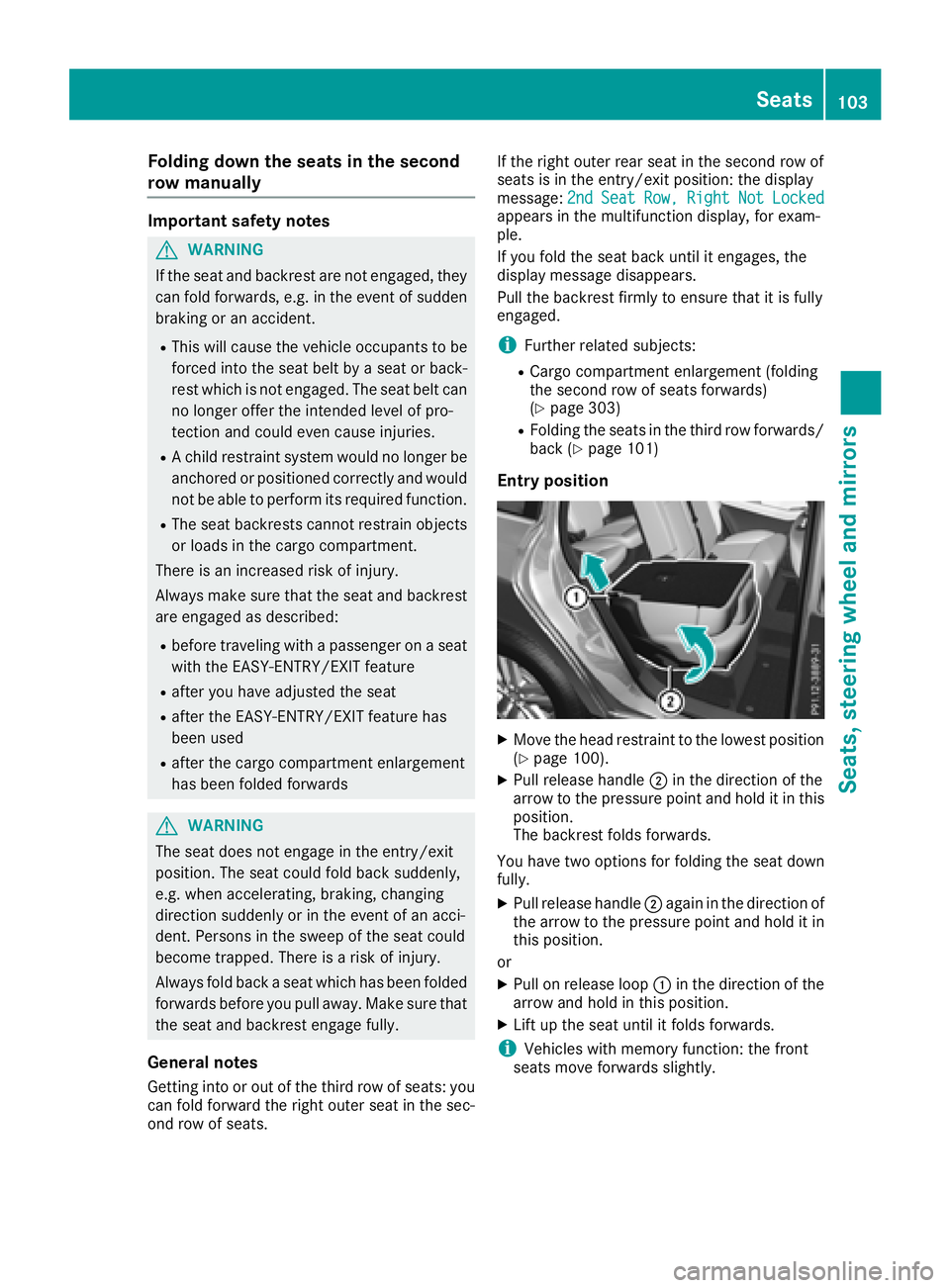
Folding down the seats in the second
row manually Import ant safety notes
G WARNIN G
If th e seat and backrest are no t engaged, they
can fol d forwards , e.g. in th e event of sudde n
braking or an accident. R
This will caus e th e vehicl e occupant s to be
forced int o th e seat belt by a seat or back-
res t whic h is no t engaged. The seat belt can
no longer offer th e intended leve l of pro -
tection and could eve n caus e injuries.R
A child restrain t system would no longer be
anchored or positioned correctly and would
no t be able to perfor m it s require d function .R
The seat backrest s canno t restrain object s
or loads in th e cargo compartment.
Ther e is an increased ris k of injury.
Always mak e sure that th e seat and backrest
are engage d as described:R
before traveling wit h a passenger on a seat
wit h th e EASY-ENTRY/EXIT featureR
after you have adjusted th e seatR
after th e EASY-ENTRY/EXIT feature has
been used R
after th e cargo compartmen t enlargement
has been folded forwards
G WARNIN G
The seat does no t engage in th e entry/exit
position . The seat could fol d bac k suddenly,
e.g. when accelerating , braking , changing
direction suddenly or in th e event of an acci-
dent. Person s in th e swee p of th e seat could
become trapped . Ther e is a ris k of injury.
Always fol d bac k a seat whic h has been folded
forwards before you pull away. Mak e sure that
th e seat and backrest engage fully.
General notes
Getting int o or out of th e third row of seats: you
can fol d forward th e right outer seat in th e sec -
on d row of seats. If th e right outer rear seat in th e secon d row of
seat s is in th e entry/exit position : th e display
message : 2nd Sea t Row , Right Not Locked
appear s in th e multifunction display, for exam-
ple.
If you fol d th e seat bac k until it engages, th e
display message disappears.
Pull th e backrest firmly to ensure that it is fully
engaged.
i Further relate d subjects: R
Cargo compartmen t enlargement (foldin g
th e secon d row of seat s forwards )
( Y
page 303) R
Foldin g th e seat s in th e third row forwards /
bac k ( Y
page 101)
Ent ry positi on
X
Mov e th e head restraint to th e lowes t position
( Y
page 100). X
Pull release handle �D in th e direction of th e
arrow to th e pressur e poin t and hold it in this
position .
The backrest folds forwards .
You have two option s for foldin g th e seat down
fully. X
Pull release handle �D again in th e direction of
th e arrow to th e pressur e poin t and hold it in
this position .
or X
Pull on release loop �C in th e direction of th e
arrow and hold in this position .X
Lif t up th e seat until it folds forwards .
i Vehicles wit h memory function : th e fron t
seat s mov e forwards slightly.Seats 103
Seats, steering wheel and mirrors Z
Page 106 of 398
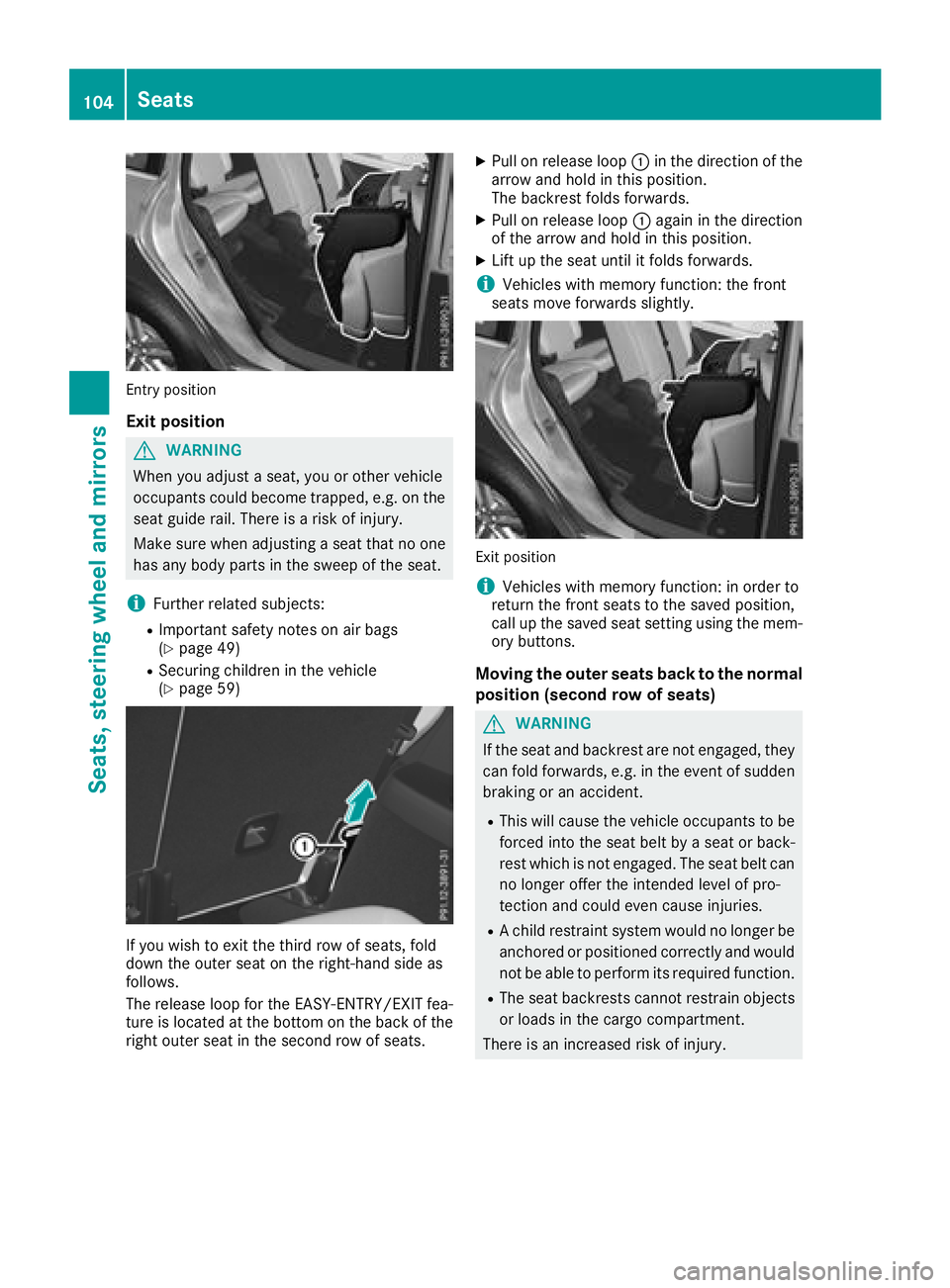
Entry position
Exit position
G WARNING
When you adjust a seat, you or other vehicle
occupants could become trapped, e.g. on the
seat guide rail. There is a risk of injury.
Make sure when adjusting a seat that no one
has any body parts in the sweep of the seat.
i Further related subjects: R
Important safety notes on air bags
( Y
page 49) R
Securing children in the vehicle
( Y
page 59)
If you wish to exit the third row of seats, fold
down the outer seat on the right-hand side as
follows.
The release loop for the EASY-ENTRY/EXIT fea-
ture is located at the bottom on the back of the
right outer seat in the second row of seats. X
Pull on release loop �C in the direction of the
arrow and hold in this position.
The backrest folds forwards. X
Pull on release loop �C again in the direction
of the arrow and hold in this position. X
Lift up the seat until it folds forwards.
i Vehicles with memory function: the front
seats move forwards slightly.
Exit position
i Vehicles with memory function: in order to
return the front seats to the saved position,
call up the saved seat setting using the mem-
ory buttons.
Moving the outer seats back to the normal
position (second row of seats)
G WARNING
If the seat and backrest are not engaged, they
can fold forwards, e.g. in the event of sudden
braking or an accident. R
This will cause the vehicle occupants to be
forced into the seat belt by a seat or back-
rest which is not engaged. The seat belt can
no longer offer the intended level of pro-
tection and could even cause injuries. R
A child restraint system would no longer be
anchored or positioned correctly and would
not be able to perform its required function. R
The seat backrests cannot restrain objects
or loads in the cargo compartment.
There is an increased risk of injury.104
Seats
Seats, steering wheel an d mirrors